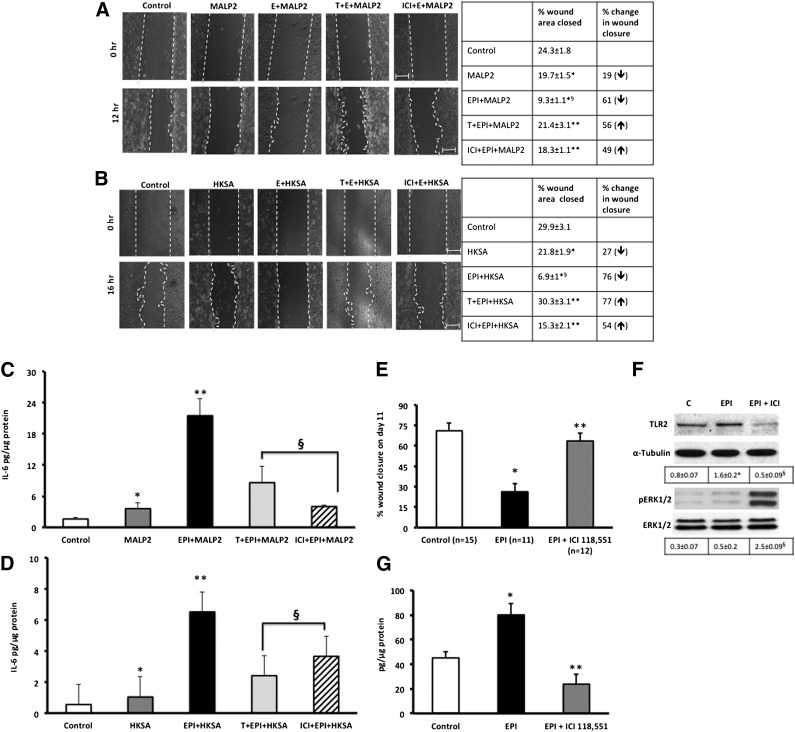Figure 6.
Blocking β2-ARs with ICI 118,551 or Timolol reverses EPI + MALP2- or EPI + HKSA-delayed NHK migration and increased IL-6 production in injured NHKs. (A): NHK monolayers were pretreated with Timolol or ICI 118,551 (10 μM, 30 minutes), followed by EPI (50 nM), MALP2 (100 ng/ml), or EPI + MALP2 treatment, and then wounded by scratches, as described in Materials and Methods. The defined areas were photographed at 0 and 12 hours after wounding. The percentage of wound area closed was calculated and presented in adjacent table along with percentage of change in wound closure (↓ = decreased wound closure; ↑ = increased wound closure). Values represent mean ± SD; ∗, p < .05 versus control; ∗∗, p < .05 versus EPI + MALP2; §, p < .01 versus MALP2 (n = 3 experiments). (B): NHK monolayers were pretreated with Timolol or ICI 118,551 (10 μM, 30 minutes), followed by EPI (50 nM), HKSA (104 cells per milliliter), or EPI + HKSA treatment, and then wounded by scratches, as described in Materials and Methods. The defined areas were photographed at 0 and 16 hours after wounding. The percentage of open and closed wound areas was calculated and presented in bar graph panel. The percentage of wound area closed was calculated and presented in adjacent table along with percentage of change in wound closure (↓ = decreased wound closure; ↑ = increased wound closure). Values represent mean ± SD, ∗, p < .05 versus control; ∗∗, p < .05 versus EPI + MALP2; §, p < .01 versus MALP2 (n = 3 experiments). (C): NHK monolayers were pretreated with ICI 118,551 or Timolol (10 μM, 30 minutes), followed by EPI (50 nM), MALP2 (100 ng/ml), or EPI + MALP2 treatment, and then wounded by scratches, as described in Materials and Methods. Cell supernatants were collected for IL-6 enzyme-linked immunosorbent assays. Values represent mean ± SD; ∗, p < .05 versus control; ∗∗, p < .05 versus MALP2; §, p < .05 versus E + MALP2 (n = 3 experiments). (D): NHK monolayers were pretreated with ICI 118,551 or Timolol (10 μM, 30 minutes), followed by EPI (50 nM), HKSA (104 cells per milliliter), or EPI + HKSA treatment, and then wounded by scratches, as described in Materials and Methods. Cell supernatants were collected for IL-6 ELISA analyses. Values represent mean ± SD; ∗, p < .05 versus control; ∗∗, p < .05 versus HKSA; §, p < .05 versus E + HKSA (n = 3 experiments). Full-thickness cutaneous wounds of EPI-stressed C57BL6J mice show decreased wound closure (E), increased TLR2 protein expression and decreased ERK1/2 phosphorylation (F), and increased local IL-6 secretion (G). Blocking β2-ARs with ICI 118,551 improves healing, decreases IL-6, TLR2 expression, and increases ERK1/2 phosphorylation in vivo. Densitometric ratios (TLR2/α-tubulin and pERK1/2/ERK1/2) are presented below the blots (F). Values represent mean ± SD; ∗, p < .05 versus control; ∗∗, p < .05 versus EPI; §, p < .05 versus EPI (n = 10–15 mice/group). Abbreviations: C, control; E, epinephrine; EPI, epinephrine; ERK, extracellular regulated kinase; HKSA, heat-killed Staphylococcus aureus; ICI, ICI-118,551; IL-6, interleukin-6; MALP2, macrophage-activating lipopeptide-2; T, Timolol; TLRs, Toll-like receptors.

